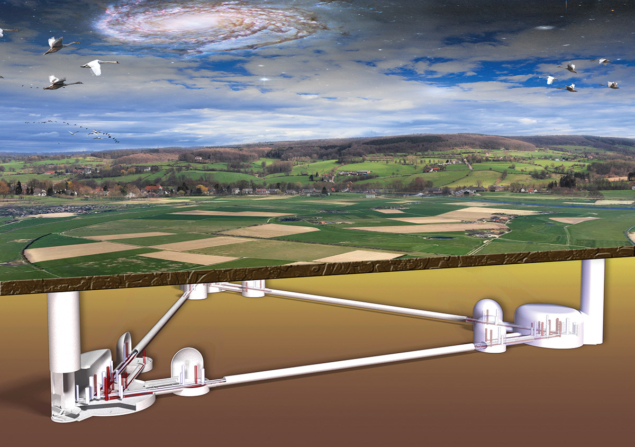
On 14 April the government of the Netherlands announced that it intends to conditionally allocate €42 million to the development of the Einstein Telescope – a proposed next-generation gravitational-wave observatory in Europe. It also pledged a further €870 million for a potential future Dutch contribution to the construction. The decision was taken by the Dutch government based on the advice of the Advisory Committee of the National Growth Fund, stated a press release from Nikhef and the regional development agency for Limburg.
The Einstein Telescope (ET) is a triangular laser interferometer with sides 10 km-long that would be at least 10 times more sensitive than the Advanced LIGO and Virgo observatories, extending its scope for detections and enabling physicists to look back much further in cosmological time. To reach the required sensitivities, the interferometer has to be built at least 200 m underground in a geologically stable area. Its mirrors will have to operate in cryogenic conditions to reduce thermal disturbance, and be larger and heavier than those currently employed to allow for a larger and more powerful laser beam.
Activities have been taking place at two potential sites in Europe: the border region of South Limburg (the Euregio Meuse-Rhine) in the Netherlands; and the Sar-Grav laboratory in the Sos Enattos mine in Sardinia, Italy. For the Sardinia site, a similar proposal has been submitted to the Italian government and feedback is expected in July.
The Netherlands’ intended €42 million investment will go towards preparatory work such as innovation of the necessary technology, location research, building up a high-tech ecosystem and organisation, stated the press release, while the reservation of €870 million is intended to put the Netherlands in a strong position to apply in the future – together with Belgium and Germany – to host and build the ET.
It is fantastic that the cabinet embraces the ambition to make the Netherlands a world leader in research into gravity waves
“It is fantastic that the cabinet embraces the ambition to make the Netherlands a world leader in research into gravity waves,” said Nikhef director Stan Bentvelsen, who has been involved with the ET for several years. “These growth-fund resources form the basis for further cooperation with our partners in Germany and Belgium, and for research into the geological subsurface in the border region of South Limburg. A major project requires a careful process, and I am confident that we will meet the additional conditions.”
Housing the ET in the region could have a major positive impact on science, the economy and society in the Netherlands, said provincial executive member for Limburg Stephan Satijn. “With today’s decision, the cabinet places our country at the global forefront of high-tech and science. Limburg is the logical place to help shape this leading position. Not only because of the suitability of our soil, but also because we are accustomed to working together internationally and to connecting science and business.”
At the 12th ET symposium in Budapest on 7–8 June, the ET scientific collaboration was officially born – a crucial step in the project’s journey, said ad interim spokesperson Michele Punturo of the INFN: “We were a scientific community, today we are a scientific collaboration, that is, a structured and organised system that works following shared rules to achieve the common goal: the realisation of a large European research infrastructure that will allow us to maintain scientific and technological leadership in this promising field of fundamental physics research.”
In January, the ET was granted status as a CERN recognised experiment (RE43), with a collaboration agreement on vacuum technology already in place and a further agreement concerning cryogenics at an advanced stage.







